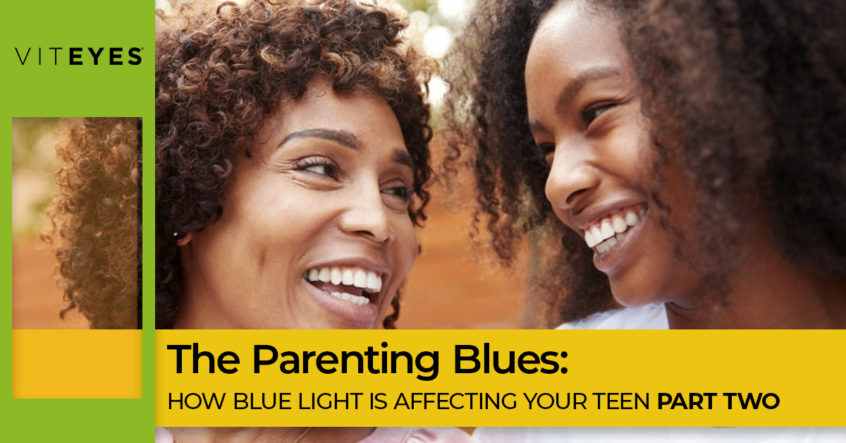In honor of Children’s Eye Health and Safety Month, we’ve devoted this series to blue light and how it impacts your child and teens alike!
In part one, we looked at what blue light is, important factors to know, and began our conversation in how blue light is affecting teens. In today’s post, we’ll continue the dialogue and explore tangible ways you can better limit your child’s exposure to blue light!
The Ways Blue Light Is Harmful
Blue light is problematic for our kids and teens in a myriad of ways, as it affects their entire body. Blue light can even be more harmful to teens because the maturing eye has the inability to filter blue light compared to the adult eye. Research is finding that kids may be at a greater risk of blue light retinal damage not only because they’re exposed at an earlier age, but also that it’s prolonged.
Blue light damage may have long-term consequences in eye health, but we have yet to see the long-term effects of this digital generation.
Because they absorb more blue light, this makes them more vulnerable to sleep disruptions. The more exposure they have to blue light during the day, especially before bedtime, the more it disrupts their natural sleep-wake cycle (circadian rhythm). So, as much as you want them to calm down with a show before bed, this may have long-term effects on their sleep.
If you have teens, you know what happens when their sleep is disrupted! Not only are they cranky, but it also impacts how they function every day. Without proper sleep, they may find themselves having a hard time staying awake and concentrating in school, leading to learning issues.
Sleep is also a vital time for teens in growth, and they need it for essential development.
What can you do to limit your child’s exposure to blue light?
Create digital boundaries – You won’t always be around to monitor their device usage, but you can develop a plan of action at home. Consider the following:
- Set limits on screen time
- Encourage activity that doesn’t involve screens
- Create screen-free zones
- Don’t parent with screens
- Be a good role model
Put f.lux on all of their devices – F.lux is a free, downloadable program that limits the exposure to blue light. This is a great solution when they are on screens.
Make sure they are getting the right nutrition – Lutein and zeaxanthin are great for helping to block blue light. These nutrients are found in dark, leafy green vegetables – like kale and spinach – or in eggs (especially the yolk). If your kids or teens aren’t getting the right nutrition, you can try a supplement with lutein and zeaxanthin.
Blue light is not inherently bad, it’s just when we’re over exposed to it long-term where it begins to cause issues. And, for kids, this is amplified. They have even more of a difficult time filtering blue light, which causes issues from sleep disruption and eye concerns.
The great news is, as a parent you can implement practical and easy things that better limit their blue light exposure — from setting digital boundaries for them at home and being a good role model or by making sure they are getting the right nutrients.
As a parent, there are so many things you have to worry about and we want to make it easier on you! Browse our website for additional vision resources today.
